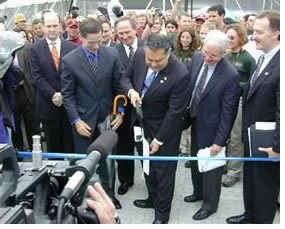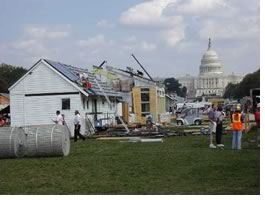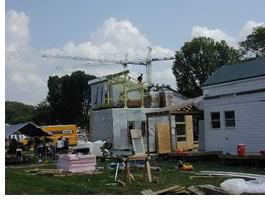

Executive Editor
 What
sounded so fantastically farfetched a year ago as organizers finalized
their plans is now a reality. The Solar Decathlon—where 14 interdisciplinary
teams of college students have built 500-square-foot energy-efficient
homes on the Capital Mall in Washington, D.C.—is off and running.
What
sounded so fantastically farfetched a year ago as organizers finalized
their plans is now a reality. The Solar Decathlon—where 14 interdisciplinary
teams of college students have built 500-square-foot energy-efficient
homes on the Capital Mall in Washington, D.C.—is off and running.
 Each
team of architecture, engineering, business, and journalism majors representing
schools from Puerto Rico to Colorado has had the task of designing, financing,
publicizing, and building a home that will produce enough electricity
while the students live in it for a week to run the lights, airconditioning,
a kitchen, a home office, and an electric car. Teams will use their electric
cars to deliver groceries to a homeless shelter and to race around East
Potomac Park a few miles away from the competition site.
Each
team of architecture, engineering, business, and journalism majors representing
schools from Puerto Rico to Colorado has had the task of designing, financing,
publicizing, and building a home that will produce enough electricity
while the students live in it for a week to run the lights, airconditioning,
a kitchen, a home office, and an electric car. Teams will use their electric
cars to deliver groceries to a homeless shelter and to race around East
Potomac Park a few miles away from the competition site.
 Sited
directly opposite the Air and Space Museum about halfway between the Capitol
and the Washington Monument, the Solar Decathlon Village occupies one
of the most heavily traversed areas in monumental Washington. The event
promises to draw throngs of people, and sponsors are providing volunteers—including
AIA members and staff—to guide tours, greet visitors, and monitor
the competition. The AIA Media Relations team has contributed to the effort
by interesting Parade magazine
into writing a highlight (in its August 25, 2002, issue) and getting a
promise of coverage from Good Morning
America.
Sited
directly opposite the Air and Space Museum about halfway between the Capitol
and the Washington Monument, the Solar Decathlon Village occupies one
of the most heavily traversed areas in monumental Washington. The event
promises to draw throngs of people, and sponsors are providing volunteers—including
AIA members and staff—to guide tours, greet visitors, and monitor
the competition. The AIA Media Relations team has contributed to the effort
by interesting Parade magazine
into writing a highlight (in its August 25, 2002, issue) and getting a
promise of coverage from Good Morning
America.
 Cosponsors
of the competition along with the AIA are the U.S. Department of Energy,
the National Renewable Energy Laboratory, BP Solar, Home Depot, and Electronic
Data Systems. AIA Executive Vice President/CEO Norman L. Koonce, FAIA,
and Energy Secretary Spencer Abraham were among the speakers at the competition
opening September 26. The winner will be announced at noon October 5.
Cosponsors
of the competition along with the AIA are the U.S. Department of Energy,
the National Renewable Energy Laboratory, BP Solar, Home Depot, and Electronic
Data Systems. AIA Executive Vice President/CEO Norman L. Koonce, FAIA,
and Energy Secretary Spencer Abraham were among the speakers at the competition
opening September 26. The winner will be announced at noon October 5.
The competing schools and their themes are:
• Auburn University, A House Inspired by Our Forefathers
• Carnegie Mellon University, A Dose of Urban Reality
• Crowder College, Exchanging Ideas Energizes the Community
• Texas A&M University, A Melting Pot of Solar Ideas
 •
Tuskegee University, New Solar for the Old South
•
Tuskegee University, New Solar for the Old South
• University of Colorado at Boulder, Solar Energy in Just About Any
House
• University of Delaware, Living with the Sun
• University of Maryland, The Home-Team Advantage
• University of Missouri—Rolla, Going Solar with Comfort and
Style
• University of North Carolina at Charlotte, Marine Applications
Come Ashore
• University of Puerto Rico, A Climate Challenge Takes to the Seas
• University of Texas at Austin, An RV Trailer Parked in a Living
Room
• University of Virginia, It's Not Your Father's House
• Virginia Polytechnic Institute and State University, The Art of
Integration.
Copyright 2002 The American Institute of Architects. All rights reserved.
![]()
|
For a daily photo log (starting September 20 and running throughout the competition), descriptions of the 10 competitions (including, of course, design), links to each team's Web site (also a part of the competition criteria), and more, visit the Solar Decathlon Web site. |
|